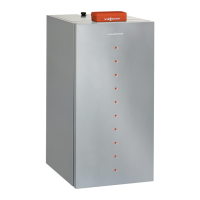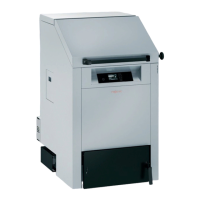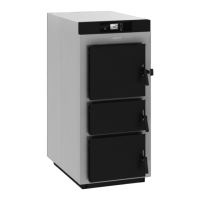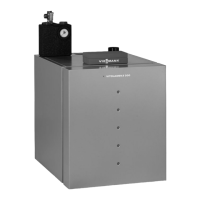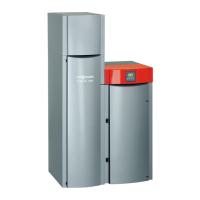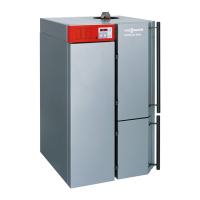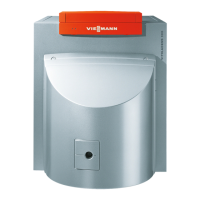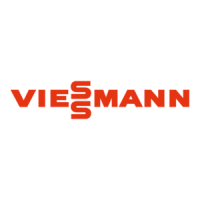


Do you have a question about the Viessmann VITOLIGNO 300-C and is the answer not in the manual?
General safety advice to prevent accidents and material losses.
Explanation of warning symbols used in safety instructions.
Defines who the operating instructions are intended for.
Guidelines for connecting and operating the appliance safely.
Rules for performing work on the appliance.
Instructions on what to do if flue gas is detected.
Actions to take in case of fire.
Guidance on handling heating system faults.
Requirements for the installation location to ensure safe operation.
Warning about the interaction of extractors and boiler operation.
Advice on using approved components and parts.
Explanation of symbols used in the manual.
Defines the proper and intended use of the appliance.
Requirements for wood pellets used in the boiler.
Information on how pellets are supplied.
Details on the initial setup and adjustment by a heating contractor.
Default factory settings for central heating, DHW, frost protection, etc.
Glossary of terms used in the manual.
Advice on optimizing energy consumption.
Identification of the main parts of the boiler.
Overview of the programming unit's buttons and screen.
Steps to take before starting the boiler.
Instructions for manually filling the pellet hopper.
Actions to take if the boiler overheats, including resetting the safety cut-out.
How to navigate through the control unit's menus.
Explanation of the start-stop button's indicators and functions.
Overview of the standard and extended menu structures.
Accessing and using the standard menu for frequent settings.
Accessing and using the extended menu for less frequent functions.
Information about the screensaver function.
Accessing the help function for explanations and guidance.
Points to check before setting up central heating.
How to choose the specific heating circuit for adjustments.
Adjusting standard and reduced room temperatures.
Setting the lower temperature for night or absence.
Selecting the heating mode (e.g., Heating, Standby).
Defining daily heating schedules.
Defining specific start and end times for heating periods.
Removing previously set time periods.
Resetting time programs to default.
Adjusting the relationship between outside and flow temperatures.
Modifying heating curve parameters.
Switching central heating to standby mode.
Temporarily increasing temperature for comfort.
How party mode automatically concludes.
Reducing temperature to save energy.
How economy mode automatically concludes.
Setting a program for extended absences.
Defining departure and return dates for the holiday program.
How to end the holiday program early.
Modifying an existing holiday program.
Points to check before setting up DHW heating.
Adjusting the domestic hot water temperature.
Selecting the DHW heating mode.
Defining daily DHW heating schedules.
Removing specific DHW heating time periods.
Resetting DHW time programs to default.
Switching DHW heating to standby mode.
Choosing automatic, manual, or off mode for the buffer cylinder.
Setting a fixed temperature for manual buffer operation.
Defining daily heating times for the buffer cylinder.
Removing specific buffer cylinder time periods.
Adjusting the heating curve for the buffer cylinder.
Setting specific times for pellet charging.
Defining the time windows for pellet supply.
Removing specific blocking time periods.
Resetting blocking times to default.
Configuring pellet suction wands.
Adjusting the fuel assignment percentage for each wand.
Procedures for clearing blocked suction wands.
Adjusting the screen's contrast level.
Adjusting the screen's brightness level.
Assigning custom names to heating circuits.
Adjusting the system's clock and calendar.
Changing the display language.
Selecting Celsius or Fahrenheit for temperature display.
Adjusting the boiler's water temperature setting.
Adjusting flue gas residual oxygen settings (consult contractor).
Defining the minimum temperature before boiler activation.
Resetting all modified parameters to default.
Displaying and acknowledging error codes.
Retrieving previously acknowledged fault messages.
Accessing system data and status information.
Viewing system data via the standard menu.
Viewing detailed system data via the extended menu.
Displaying various temperature readings.
Viewing temperatures via the standard menu.
Checking buffer cylinder temperatures via the standard menu.
Viewing detailed temperatures via the extended menu.
Procedures for turning off the system for long periods, with contractor advice.
Specific actions for shutting down the system, including disconnecting power and draining.
Causes and remedies for cold rooms.
Causes and remedies for overheating rooms.
Causes and remedies for lack of hot water.
Causes and remedies for excessively hot domestic hot water.
Actions to take when a fault message appears.
General advice on regular system upkeep.
Safety precautions and procedure for fuse replacement (contractor only).
Information on cleaning the boiler and associated parts.
Schedule of maintenance tasks for user and contractor.
Instructions and safety notes for emptying the ash box.
Glossary of technical terms used in the manual.
Tips for optimizing system performance and longevity.
Procedures for safely removing and disposing of the system.
How to dispose of product packaging.
Guidelines for disposing of the entire system.
Additional advice for reducing energy consumption.
General safety advice to prevent accidents and material losses.
Explanation of warning symbols used in safety instructions.
Defines who the operating instructions are intended for.
Guidelines for connecting and operating the appliance safely.
Rules for performing work on the appliance.
Instructions on what to do if flue gas is detected.
Actions to take in case of fire.
Guidance on handling heating system faults.
Requirements for the installation location to ensure safe operation.
Warning about the interaction of extractors and boiler operation.
Advice on using approved components and parts.
Explanation of symbols used in the manual.
Defines the proper and intended use of the appliance.
Requirements for wood pellets used in the boiler.
Information on how pellets are supplied.
Details on the initial setup and adjustment by a heating contractor.
Default factory settings for central heating, DHW, frost protection, etc.
Glossary of terms used in the manual.
Advice on optimizing energy consumption.
Identification of the main parts of the boiler.
Overview of the programming unit's buttons and screen.
Steps to take before starting the boiler.
Instructions for manually filling the pellet hopper.
Actions to take if the boiler overheats, including resetting the safety cut-out.
How to navigate through the control unit's menus.
Explanation of the start-stop button's indicators and functions.
Overview of the standard and extended menu structures.
Accessing and using the standard menu for frequent settings.
Accessing and using the extended menu for less frequent functions.
Information about the screensaver function.
Accessing the help function for explanations and guidance.
Points to check before setting up central heating.
How to choose the specific heating circuit for adjustments.
Adjusting standard and reduced room temperatures.
Setting the lower temperature for night or absence.
Selecting the heating mode (e.g., Heating, Standby).
Defining daily heating schedules.
Defining specific start and end times for heating periods.
Removing previously set time periods.
Resetting time programs to default.
Adjusting the relationship between outside and flow temperatures.
Modifying heating curve parameters.
Switching central heating to standby mode.
Temporarily increasing temperature for comfort.
How party mode automatically concludes.
Reducing temperature to save energy.
How economy mode automatically concludes.
Setting a program for extended absences.
Defining departure and return dates for the holiday program.
How to end the holiday program early.
Modifying an existing holiday program.
Points to check before setting up DHW heating.
Adjusting the domestic hot water temperature.
Selecting the DHW heating mode.
Defining daily DHW heating schedules.
Removing specific DHW heating time periods.
Resetting DHW time programs to default.
Switching DHW heating to standby mode.
Choosing automatic, manual, or off mode for the buffer cylinder.
Setting a fixed temperature for manual buffer operation.
Defining daily heating times for the buffer cylinder.
Removing specific buffer cylinder time periods.
Adjusting the heating curve for the buffer cylinder.
Setting specific times for pellet charging.
Defining the time windows for pellet supply.
Removing specific blocking time periods.
Resetting blocking times to default.
Configuring pellet suction wands.
Adjusting the fuel assignment percentage for each wand.
Procedures for clearing blocked suction wands.
Adjusting the screen's contrast level.
Adjusting the screen's brightness level.
Assigning custom names to heating circuits.
Adjusting the system's clock and calendar.
Changing the display language.
Selecting Celsius or Fahrenheit for temperature display.
Adjusting the boiler's water temperature setting.
Adjusting flue gas residual oxygen settings (consult contractor).
Defining the minimum temperature before boiler activation.
Resetting all modified parameters to default.
Displaying and acknowledging error codes.
Retrieving previously acknowledged fault messages.
Accessing system data and status information.
Viewing system data via the standard menu.
Viewing detailed system data via the extended menu.
Displaying various temperature readings.
Viewing temperatures via the standard menu.
Checking buffer cylinder temperatures via the standard menu.
Viewing detailed temperatures via the extended menu.
Procedures for turning off the system for long periods, with contractor advice.
Specific actions for shutting down the system, including disconnecting power and draining.
Causes and remedies for cold rooms.
Causes and remedies for overheating rooms.
Causes and remedies for lack of hot water.
Causes and remedies for excessively hot domestic hot water.
Actions to take when a fault message appears.
General advice on regular system upkeep.
Safety precautions and procedure for fuse replacement (contractor only).
Information on cleaning the boiler and associated parts.
Schedule of maintenance tasks for user and contractor.
Instructions and safety notes for emptying the ash box.
Glossary of technical terms used in the manual.
Tips for optimizing system performance and longevity.
Procedures for safely removing and disposing of the system.
How to dispose of product packaging.
Guidelines for disposing of the entire system.
Additional advice for reducing energy consumption.
| Fuel Type | Wood pellets |
|---|---|
| Emission Class | 5 |
| Efficiency | 95% |
| Modulation | Yes |
| Output Range | 2.4 – 48 kW (depending on the model) |
